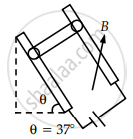Advertisements
Advertisements
प्रश्न
An electron emitted by a heated cathode and accelerated through a potential difference of 2.0 kV, enters a region with uniform magnetic field of 0.15 T. Determine the trajectory of the electron if the field (a) is transverse to its initial velocity, (b) makes an angle of 30° with the initial velocity.
उत्तर
Magnetic field strength, B = 0.15 T
Charge on the electron, e = 1.6 × 10−19 C
Mass of the electron, m = 9.1 × 10−31 kg
Potential difference, V = 2.0 kV = 2 × 103 V
Thus, kinetic energy of the electron = eV
eV = `1/2"mv"^2`
v = `sqrt((2"eV")/"m")` .........(1)
Where,
v = velocity of the electron
(a) Magnetic force on the electron provides the required centripetal force of the electron. Hence, the electron traces a circular path of radius r.
Magnetic force on the electron is given by the relation,
Centripetal force = `"mv"^2/"r"`
∴ Bev = `"mv"^2/"r"`
r = `"mv"/"Be"` .............(2)
From equations (1) and (2), we get
r = `"m"/"Be" [(2"eV")/"m"]^(1/2)`
= `(9.1 xx 10^-31)/(0.15 xx 1.6 xx 10^-19) xx ((2 xx 1.6 xx 10^-19 xx 2 xx 10^3)/(9.1 xx 10^-31))^(1/2)`
= 100.55 × 10−5
= 1.01 × 10−3 m
= 1 mm
Hence, the electron has a circular trajectory of a radius of 1.0 mm normal to the magnetic field.
(b) When the field makes an angle θ of 30° with an initial velocity, the initial velocity will be,
v1 = v sin θ
From equation (2), we can write the expression for the new radius as:
r1 = `("mv"_1)/("Be")`
= `("mv" sin θ)/"Be"`
= `(9.1 xx 10^-31)/(0.15 xx 1.6 xx 10^-19) xx [(2 xx 1.6 xx 10^-19 xx 2 xx 10^3)/(9 xx 10^-31)]^(1/2) xx sin 30°`
= 0.5 × 10−3 m
= 0.5 mm
Hence, the electron has a helical trajectory of radius 0.5 mm along the magnetic field direction.
APPEARS IN
संबंधित प्रश्न
Two wires carrying equal currents i each, are placed perpendicular to each other, just avoiding a contact. If one wire is held fixed and the other is free to move under magnetic forces, what kind of motion will result?
A straight horizontal wire of mass 10 mg and length 1.0 m carries a current of 2.0 A. What minimum magnetic field B should be applied in the region, so that the magnetic force on the wire may balance its weight?
If a particle of charge 1012 coulomb moving along the `hat"x" -` direction with a velocity 102 m/s experiences a force of 1 o-s newton in `hat"y" -` direction due to magnetic field, then the minimum magnetic field is ____________.
The magnetic moment is NOT associated with ____________.
A solenoid 60 cm long and of radius 4.0 cm has 3 layers of windings of 300 turns each. A 2.0 cm long wire of mass 2.5 g lies inside the solenoid (near its centre) normal to its axis; both the wire and the axis of the solenoid are in the horizontal plane. The wire is connected through two leads parallel to the axis of the solenoid to an external battery which supplies a current of 6.0 A in the wire. What value of current (with appropriate sense of circulation) in the windings of the solenoid can support the weight of the wire? (g = 9.8 m s–2)
A charged particle of charge e and mass m is moving in an electric field E and magnetic field B. Construct dimensionless quantities and quantities of dimension [T]–1.
Two long current-carrying conductors are placed parallel to each other at a distance of 8 cm between them. The magnitude of the magnetic field produced at the mid-point between the two conductors due to the current flowing in them is 300µT. The equal current flowing in the two conductors is ______.
Two conducting rails are connected to a source of emf and form an incline as shown in figure. A bar of mass 50 g slides without friction down the incline through a vertical magnetic field B. If the length of the bar is 50 cm and a current of 2.5 A is provided by battery. Value of B for which the bar slide at a constant velocity ______ × 10-1 Tesla. 2 [g = 10 m/s2]

With a neat labelled diagram, explain cyclotron motion and cyclotron formula.
